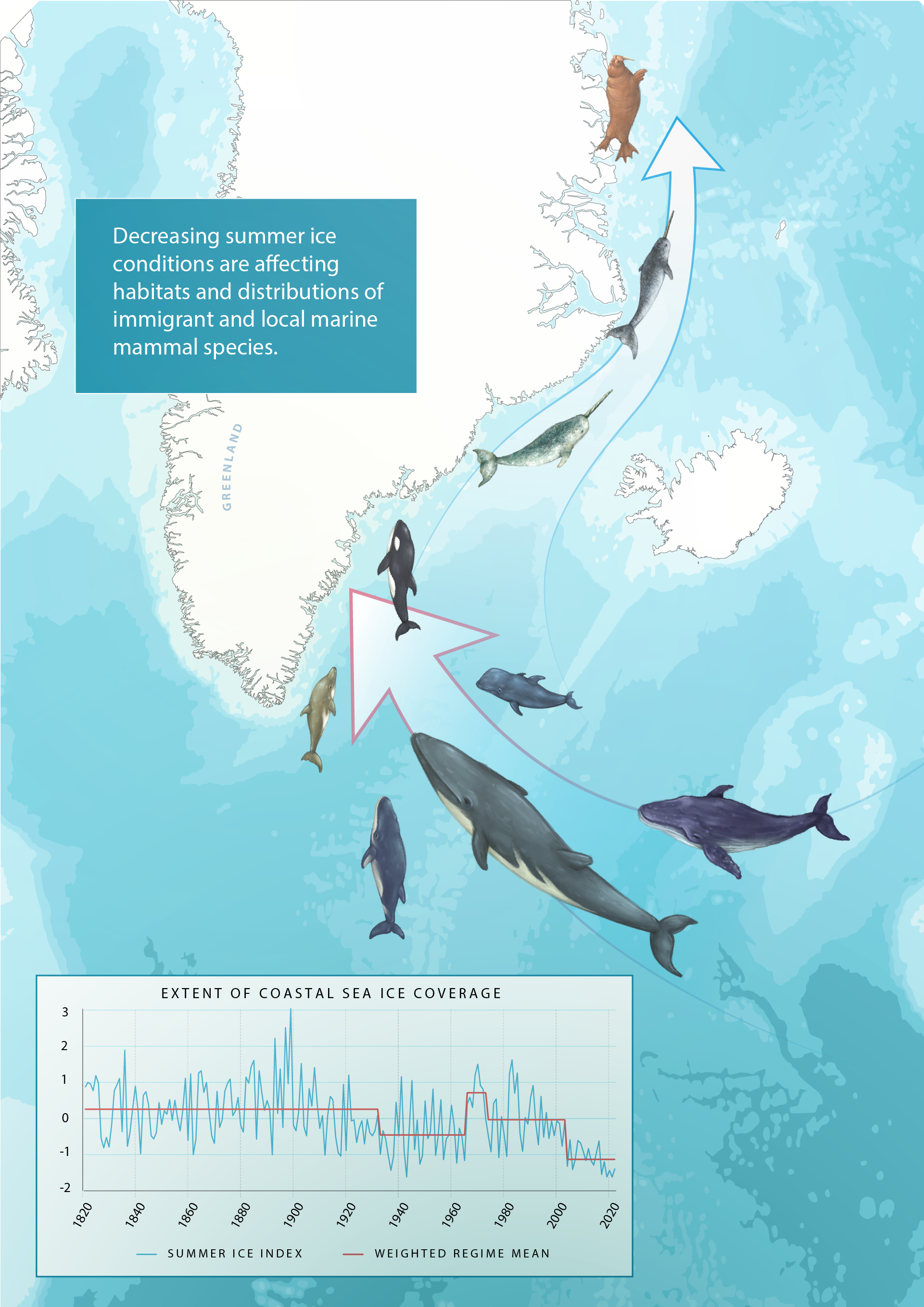A Regime Shift In An Arctic Marine Ecosystem That Is Likely To Become Permanent
by Professor Mads Peter Heide-Jørgensen and Professor Brian MacKenzie | Published: 21-Nov-22 | Last updated: 17-Nov-22 | Tags : | category:

Illustration: GRID-Arendal
Findings of unexpectedly large numbers of fin and humpback whales in the previously ice infested waters of East Greenland now indicate a tipping point in the marine ecosystem from one regime to another that may be irreversible.
A sub-arctic ecosystem off Southeast Greenland
dominated by large amounts of drifting pack ice has changed during this century
to a more temperate system with less sea ice and warmer ocean temperatures.
These changes in summer ocean conditions are making the region more attractive
for large numbers of fin and humpback whales, and other new species.
Dramatic ecological changes such as these are
considered regime shifts in the ecological literature. Shifts from one regime
to another occur at a tipping point and may be irreversible. The regime shift
has cascading effects throughout the ecosystem.
These are the conclusions in a new scientific study published in the internationally peer-reviewed scientific journal Global
Change Biology.
The study is led by the Greenland Institute of Natural
Resources with contributions from the National Institute of Aquatic Resources, at the Technical
University of Denmark.
“In this case, the new regime will likely become
permanent for the foreseeable future, unless temperatures cool and the ice
export from the north increases again. According to recent IPCC reports,
continued 21st century climate change make this scenario unlikely,” says
Professor Mads Peter Heide-Jørgensen, Greenland Institute of Natural
Resources.
“One of the main findings is that this event
is so unusual in the past 200 years of summer ice observations in the region.
We have seen big changes in some of the upper trophic levels. There are likely
many other changes in the ecosystem and food web that have not yet been
described and might be part of the reason why highly migratory species are
coming to the region,” says Professor Brian MacKenzie, National
Institute of Aquatic Resources, DTU.
Tipping
points
The driver of the shift is known as a tipping element
and the extent of drifting sea ice is an easily detectable tipping element,
nowadays including satellite imagery.
In 2012, for the first time, bluefin tunas were caught
as bycatch in a trawl fishery in waters off East Greenland. This was an eyeopener
that something dramatic has happened to the subarctic ecosystem.
Also, other evidence of ecological changes were
mounting like the unexpected large numbers of fin and humpback whales that were
found in the previously ice-infested waters of East Greenland. They started to
occur together with temperate species like dolphins, killer whales and pilot
whales. At the same time observations of high Arctic species, like narwhals and
walrus, were dwindling in Southeast Greenland.
This ecological shift in the dominating regime of East
Greenland was driven by the decline in summer drift ice along East Greenland. A
200 year long record revealed that unprecedented low levels of coastal sea ice
were reached after 2000. This opened the area to the large predators that
depend on open water for air breathing.
“The recent disappearance of summer pack ice along
East Greenland demonstrates how meteorological perturbations are connected to
changes in marine ecological conditions over distances several thousand
kilometers apart,” says Professor Mads Peter Heide-Jørgensen.
Facts
Most of the pack ice in the Arctic Ocean is generated
in a circulation system north of Alaska from where it, for several years, is
pushed by currents towards the north of Greenland. From there, most of it
drifts through the Fram Strait at high speed south along the East Greenland
coast before entering the North Atlantic.
The study is part of the EU funded ECOTIP and
a Nordic Council project investigating links between changing oceanographic
conditions and fisheries in East Greenland (AG-Fisk LEGCO). ECOTIP focuses on
tipping elements in the marine environment of the North Atlantic.
For more
information contact
Professor Mads Peter Heide-Jørgensen, Greenland
Institute of Natural Resources, mhj@ghsdk.dk, +4540257943
Professor Brian MacKenzie, National Institute of
Aquatic Resources, DTU, brm@aqua.dtu.dk, +45 21315814
